World Heritage Sites in India
40 UNESCO World Heritage Sites in India 2022
UNESCO World Heritage Convention which was established in 1972, recognised various sites of cultural and natural importance around the world. After the latest addition to the UNESCO World Heritage Sites list, India has now 40 World Heritage Sites, and that makes India with the 6th largest number of World Heritage Sites in the world! There are 32 cultural sites, 7 natural sites and 1 mixed as recognised by UNESCO.
Heritage Sites in Uttar Pradesh
Taj Mahal (Cultural) (1983)

One of the world’s seven wonders, the Taj Mahal is a gleaming white marble monument located on the banks of river Yamuna in the bustling city of Agra. Commissioned by the great Mughal emperor Shah Jahan for his beloved wife, this iconic tomb symbolizes the love and the brilliant architecture of the Mughal empire. This shining jewel of Islamic art is a must-visit place in India as a trip to the Taj Mahal is one of the most incredible experiences to gather in India as it is considered the best example of Mughal architecture worldwide and is called the “Jewel of Muslim Art in India”. This is probably the monument that is most recognized the world over for its association with Indian heritage sites.
Location: Dharmapuri, Forest Colony, Tajganj, Agra, Uttar Pradesh 282001
Agra Fort (Cultural) (1983)

Spread over a sprawling area of 94 acres, Agra Fort is yet another prominent heritage site in India that offers an incredible experience to travelers. Constructed with red sandstone, this marvelous Mughal monument influences Persian and Arabic architecture. Just about 2.5 kilometers from the famous Taj Mahal, Agra Fort was the main residence of the Mughals until they shifted to Delhi. Though established in Mughal Era, during the time of Akbar, the Agra Fort is a fusion of Persian art of the Timurid and Indian architecture. This is so because the fort was originally a brick monument known as Badalgarh, held by Raja Badal Singh, a Hindu Shikarwar Rajput King. After the invasion, Sikander Lodi was the first Sultan of Delhi to shift to Agra and live in the fort. The Agra Fort includes several monuments like Khas Mahal, Sheesh Mahal, Muhamman Burie(an octagonal Tower), Diwan-e-Khas, Diwan-e-Am, Moti Masjid, and Nagina Masjid.
Location: Agra Fort, Rakabganj, Agra, Uttar Pradesh 282003
Fatehpur Sikri (Cultural) (1986)
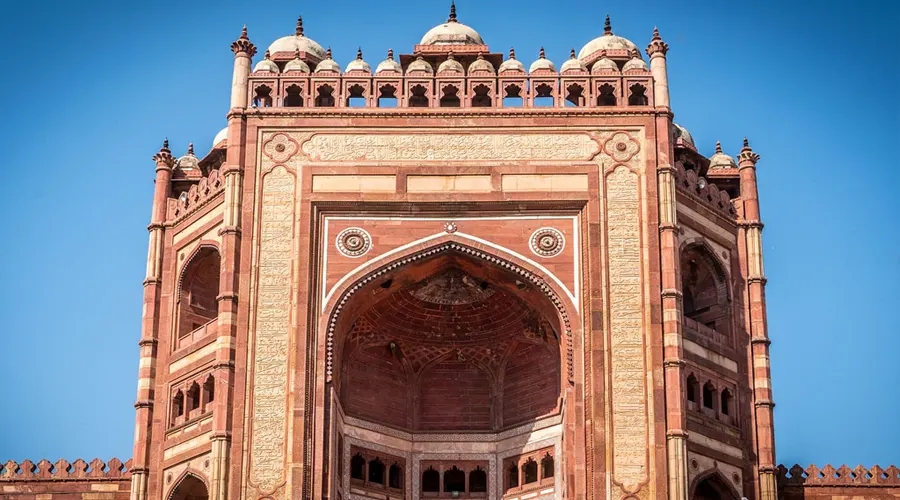
The name of the city itself denotes the victory (Fateh) of Akhbar over Chittor and Ranthambore, Fatehpur Sikri was the planned city commissioned by the Mughal Emperor, Akbar in 1571. Declared a heritage site in 1986, the Redstone palace complex constitutes four main Monuments. The Jama Masjid, The Buland Darwaza, which is the most significant door of Asia, is made of a specific wood imported from Australia which would sink in water. Panch Mahal or Jada Baai ka Mahal, which is also considered the origin place of the Navaratnas (Birbal, Tansen, etc.). It also contained the Diwan-e-Khas and Diwan-e-aam. Interior to the Buland Darwaza lies the Tomb of Salim Chishti. All these Mughal buildings are notable Indian heritage sites.
Location: Fatehpur Sikri is a small city in northern India, just west of Agra
Heritage Sites in Maharashtra
Ajanta Caves (Cultural) (1983)

One of the first World Heritage sites in India, Ajanta Caves in Aurangabad, is unequivocally majestic. Comprising 29 intricately carved rock caves, this 2000-year-old Buddhist site in Maharashtra exudes the brilliance of architecture, cave paintings, and sculptures. Ajanta Caves consist of the most beautiful masterpieces of 31 rock-cut Buddhist cave monuments, paintings, and sculptures. The caves are very built in two different phases. First of Satavahana Period under the patronage of the Satvahana Dynasty (230BCE-220CE). Second, the caves of the Vakataka Period under the reign of Emperor Harishena of the Vakataka Dynasty. The style of Ajanta art and architecture has had a revolutionary impact on the way Indian art and architecture have progressed throughout history. Having mainly carvings and sculptures related to the life of Buddha; one can say that this marks the beginning of Indian Classical Art.
Location: Ajanta, Aurangabad district, Maharashtra, India
Chhatrapati Shivaji Terminus (Cultural) (2004)

Formerly named Victoria Terminus, Chhatrapati Shivaji Terminus is an example of Victorian Gothic architecture and is the headquarters of the Central Railway in Mumbai. It was built by Frederick William Stevens with inspiration from Victorian Italianate Gothic Revival architecture and traditional Mughal buildings between the years 1878-1888 and gave Bombay the face of being the International Mercantile Port of India. In some ways, the plan of the terminal though it has Italian and Victorian-era elements reminds us of the Indian palace architecture and is an excellent example of the blending of an indigenous and western style of art.
Location: Chhatrapati Shivaji Terminus Area, Fort, Mumbai, Maharashtra 400001
Elephanta Caves (Cultural) (1987)

Known as the City of Caves, the gorgeous Elephanta caves in Maharashtra were first discovered by the Portuguese colonists. Boasting exquisite carvings and monolithic architecture, this spectacular world heritage site in Maharashtra depicts the cult worship of Lord Shiva. Holding cultural and religious values, Elephanta caves were declared a world heritage site in India in 1987. Numerous archaeological remains offer us a glimpse into the rich, cultural past of Indian civilization. These caves are famous for their rock-cut sculptures and carvings depicting Shiva as the Creator and the Destroyer of the Universe. The most important of all the caves here is Cave 1, where one can see the Sadashiva at the entrance of the cave, which depicts three sides of Shiva: the Creator, Preserver, and Destroyer. The caves are carved in solid basalt rock and lie 10 kilometers east of the city of Mumbai.
Location: Gharapuri, Maharashtra 400094
Ellora Caves (Cultural) (1983)

Yet another iconic cave, Ellora Caves, is a well-preserved UNESCO-recognised site in the country. Boasting about 100 caves, this monastery temple is one of the biggest intricately carved rock-cut structures in India. A blend of Hindu, Buddhist, and Jain cults, Ellora Caves depicts the bygone era's timeless religious harmony and artistic dexterity. The excavated site consists of Charanandri Hills, Buddhist Hindu and Jain rock-cut temples, Viharas, and Maths of the 5th and 10th centuries. There are about 34 rock-cut temples and caves which can be dated to about 600 to 1000 AD, which are essential in terms of understanding the lives of the people living in these times.
Location: Ellora Cave Rd, Ellora, Maharashtra 431102
The Victorian Gothic and Art Deco Ensembles (Cultural) (2018)

A wide collection of 19th-century Victorian neo-Gothic public buildings and 20th-century Art Deco, these two essential ensembles of Mumbai are a fine example of modernization that happened in the city of dreams during the 19th and 20th centuries. Both the Victorian Gothic buildings on the eastern side and the Art Deco ensembles on the western belt exhibit an exchange of European and Indian values over the centuries. This Oval Maidan is regarded as having heritage importance and was recognized by UNESCO in 2018. The Victorian and Art Deco Ensemble of Mumbai is a collection of 94 buildings of great cultural importance, located in the Fort Area of Mumbai, set around the Oval Maidan, previously known as Esplanade. The Oval is flanked on the east by 19th-century Victorian Neo-Gothic constructions, like the Bombay High Court, The Fort Campus of the University of Mumbai, and the Old Secretariat Building among others. On the west stand the 20th-century Art Deco buildings right along the Arabian Sea.
Location: Mumbai, India
Heritage Sites in Madhya Pradesh
Sanchi Stupa (Cultural) (1989)

One of the oldest stone structures in India, the great Stupa at Sanchi is believed to house the ashes of Lord Buddha. Comprising monolithic pillars, palaces, temples, and monasteries, this massive complex was a major Buddhist center until the 12th century A.D. Holding universal value, the Stupa at Sanchi was erected by the great Mauryan Emperor, Ashoka after he embraced Buddhism in 250 BC. Exquisitely engraved pillars, walls, and torans on the entrance depict the wonderful craftsmanship of the Mauryan Era which are worth witnessing.
Location: Sanchi Town, Raisen district, Madhya Pradesh, India
Khajuraho Group of Monuments (Cultural) (1986)
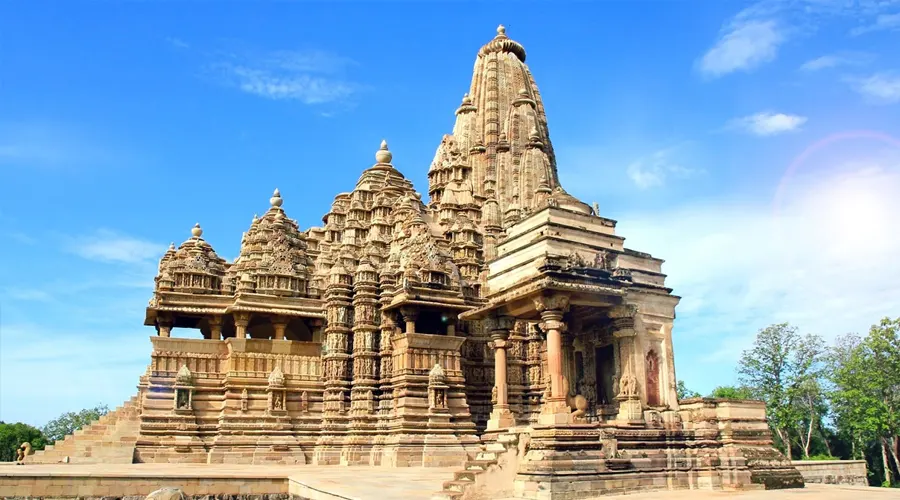
Depicting some of the finest art in the world, the temples of Khajuraho are popular for their architectural brilliance. Built during the Chandela dynasty from 900 CE to 1130 CE, the Khajuraho Group of Monuments are known for their erotic sculptures that reflect female beauty and fertility. The epitome of beauty, this massive temple complex in Madhya Pradesh is one of the gems of Indian Heritage that is also recognized by UNESCO. These sensuous stone carvings of human and animal forms in erotic poses are very aesthetically portrayed and stand testimony to the rich cultural heritage of India. It consists of a total of 85 Temples spread across an area of 20 square kilometers. The Kandariya temple is the most prominent of all of these temples in the Khajuraho complex.
Location: Chhatarpur, Madhya Pradesh, India
Rock Shelters of Bhimbetka (Cultural) (2003)

Declared a Unesco World Heritage Site in 2003, the Rock Shelters of Bhimbetka is the place where the earliest traces of human life on the Indian subcontinent was discovered. They’re located at the foothills of the Vindhya Mountains in the Deccan Plateau and are an archaeological site for the Mesolithic period (more than 100,000 years ago) and thus indicate the beginning of the South Asian Stone Age. The rock shelters comprise a group of 5 rocks that were discovered only in 1957 and are renowned for the Mesolithic era carvings and paintings. These paintings are instrumental in telling us about the life and activities of the hunter-gatherers who preceded us and showed the coming together of art form and landscape, during that age.
Location: Bhojpur Raisen, Madhya Pradesh 464990
Heritage Sites in Delhi
Humayun's Tomb (Cultural) (1993)

One of the spectacular tombs in Delhi built during the Mughal era, the Humayun's Tomb is a perfect example of gorgeous Persian and Islamic architecture. Known as Maqbara-e-Humayun, there are around 150 tombs in the entire Humayun tomb complex that are built with red sandstone, and white marble domes. Commissioned by Hamida Banu Begum in 1565 AD, the construction of the tomb was completed by Humayun's son Sayyid Muhammad ibn Mirak Ghiyath Ud Din in 1572 AD.
Location: Damini Road, Nizamuddin West, Delhi, India
Qutub Minar and its Monuments (Cultural) (1993)
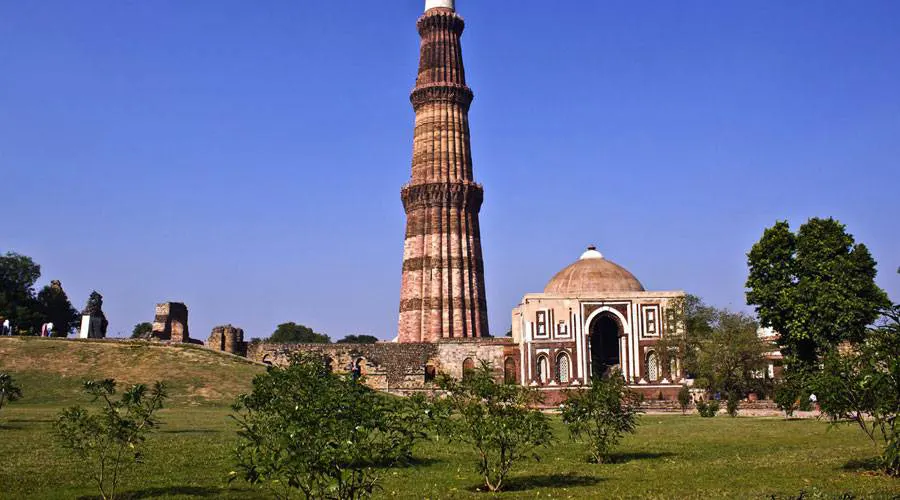
Built in the 13th century by Qutab-Ud-din Aibak after the defeat of the last Hindu kingdom, Qutub Minar stands tall at the soaring height of 73m in the Mehrauli region of the capital city. Also known as the tower of victory, this 5-story minaret signifies the beginning of Muslim rule in India and is the major highlight of the Qutub complex, which is recognized as a prominent UNESCO Heritage site in India. The Qutub Minar is one of the several other buildings located within the Qutub complex, and it occupies the center stage mainly due to its height. It is 73 meters tall and has a diameter of 15 m at the base and 2.5 m at the top. It was built by Aibak to honor the famous Sufi saint Qutbuddin Bakhtiar Kaki. The complex houses other significant monuments like the Quwwat-ul-Islam Mosque, Alai Darwaza, Alai Minar, and the tomb of Iltutmish, which highlights the rich history of Delhi.
Red Fort Complex (Cultural) (2007)

The main residence of the fifth Mughal emperor, Shah Jahan, the Red Fort complex became the new capital of the Mughals in 1639. The erstwhile Quila-e-Mubarak (Blessed Fort), the Red Fort lying along the banks of the river Yamuna in Old Delhi, got its new name due to its massive red stone fortification. Under Shah Jahan, Mughal art and architecture reached their zenith, and the Red Fort is the perfect example of that. One can see the blending of Indo-Islamic, Timurid, Hindu, and Persian forms of architecture in several facets of the Red Fort. It’s made up of red sandstone and houses several other smaller buildings such as the private pavilions, the Diwan-i-Aam, and the Diwan-i-Khas. Also known as Shahzanabad, this massive Redstone fort adjacent to the Salimgarh Fort, built by Islam Shah Suri in 1546 together, comes under the Red Fort Complex. Due to its geo-cultural impact and architectural brilliance, the Red Fort complex was recognized as one of the world heritage sites in India in 2007 and is managed directly by the Archaeological Survey of India.
Location: Netaji Subhash Marg, Lal Qila, Chandni Chowk, New Delhi, Delhi 110006
Heritage Sites in Rajasthan
Keoladeo National Park (Natural) (1985)
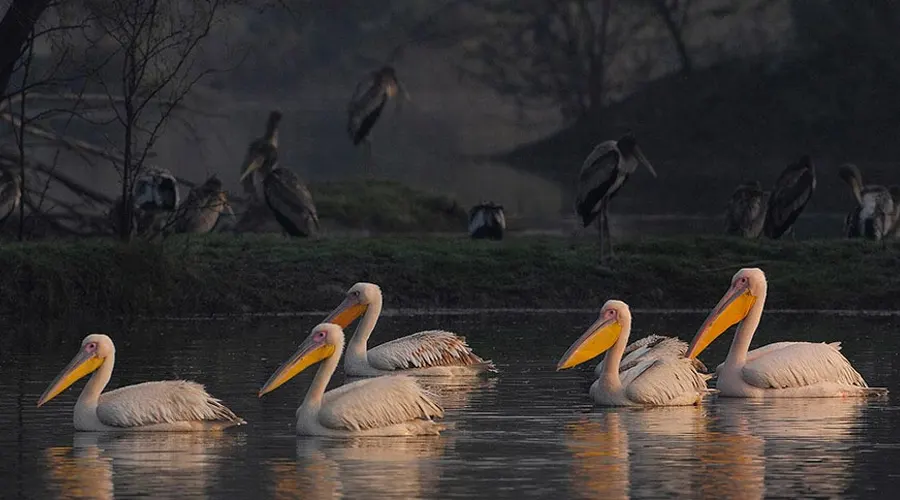
Also known as Bharatpur Bird Sanctuary, Keoladeo National Park is located in the Indian state of Rajasthan. Home to about 366 different species of birds, it’s also known for being the wintering and nesting ground for several non-indigenous, migratory birds. It has been acknowledged as one of the best national parks in the world. Formerly a popular hunting ground for the royal family of Bharatpur around 250 years ago, the park was declared a sanctuary in 1976. Also known as Bharatpur Bird Sanctuary, it became a heritage site in 1985 owing to the antiquity and montage of features. Besides birds, there are 379 floral species, 50 species of fish, 13 species of snake, seven species of lizard, seven species of amphibians, seven turtle species, and a variety of other invertebrates. This place is a reminder of the rich biological heritage of India.
Location: Bharatpur, Rajasthan, India
Hill Forts of Rajasthan (Cultural) (2013)

The land of Forts and Palaces, Rajasthan, is replete with magnificent forts perched on hills that are an integral part of the rich Indian heritage. The spectacular Chittorgarh Fort, Kumbhalgarh Fort boasting the second largest wall in the world, Gagron Fort, famous for Sati culture in India, exceptionally beautiful Amer Fort, shimmering golden Jaisalmer Fort, and the ancient fort of Ranthambore together come under Hill Forts of Rajasthan that are recognized as the World UNESCO Heritage Sites. Preserving the legacy of Rajputana culture, these hill forts have an irresistible charm. Also, these forts had unique water storage and harvesting structures, which are being used even today. It is also known for being the shooting location of the movie, The Dark Knight Rises and a few films by Satyajit Ray like ‘Shonar Kella’.
Location: Rajasthan, India
The Pink City Jaipur (Cultural) (2019)

With the newest addition to the list of UNESCO world heritage sites in India, Jaipur joined the club on 6th June 2019. It is one of the largest cities in India and is surrounded by walls and gates decorated with drawings on the backdrop of a beautiful pink hue, Jaipur, the pink city successfully manages to retain its old-world charm. Home to a few other UNESCO World Heritage sites including Amer Fort and Jantar Mantar, Jaipur is home to many magnificent forts, palaces, temples, and museums. Jaipur is filled to the brim with bustling local bazaars where you can shop for local handicrafts and trinkets to your heart's content. Popular bazaars in the city include Bapu Bazaar, Tripolia Bazaar, and Johri Bazaar.
Location: Jaipur is the capital of India’s Rajasthan state.
Jantar Mantar (Cultural) (2010)

Built by the Rajput king Sawai Jai Singh II, the founder of Jaipur, Jantar Mantar is a collection of 19 astronomical instruments. Built in the 18th century, this stone-made observatory boasts the astronomical, engineering, and cosmological prowess of the ancient Indians. It features the world's largest stone sundial and is a UNESCO World Heritage site. This is one of the largest observatories in the World, consisting of interesting stone structures that help to interpret the position of celestial bodies and calculate local time. The best time to visit Jantar Mantar is at noon when the Sun is vertically above, which gives a view of the readings of each instrument. One of India’s best-preserved observatories, this monument is an excellent example of the scientific as well as the cultural heritage of India.
Location: Gangori Bazaar, J.D.A. Market, Pink City, Jaipur, Rajasthan 302002
Heritage Sites in Gujarat
Champaner-Pavagadh Archaeological Park (Natural) (2004)

Boasting archaeological, historical, and living cultural heritage aspects sprawling over an impressive landscape, Champaner-Pavagadh Archaeological Park was declared a UNESCO-affiliated heritage site due to its strategic features. This expansive heritage property from the 14th & 15th centuries is home to fortifications, palaces, shrines, residential buildings, water retaining installations, and the living village of Champaner. This Archaeological Park in Gujarat is also a significant pilgrimage place for Hindus.
Location: Champaner, Gujarat 389360
The Historic City of Ahmedabad (Cultural) (2017)

The first city in India to enter the list, Ahmedabad was declared a World Heritage City on July 8, 2017. The city of Ahmedabad has close to 25 ASI (Archaeological Survey of India) protected structures. According to a statement from UNESCO "The urban fabric is made up of densely-packed traditional houses in gated traditional streets with characteristic features such as bird feeders, public wells and religious institutions. The city continued to flourish as the capital of the State of Gujarat for six centuries, up to the present”.. Known for its rich architectural heritage, vibrant culture, and deeply rooted traditions, the city is studded with many Indo-Islamic monuments from the 15th to 17th centuries. The city of Ahmedabad also witnessed the freedom revolution led by Mahatma Gandhi against the Britishers. Despite urbanization and all the developments that have happened over centuries, the colorful city basks in glorifying heritage left by different kingdoms from the past.
Location: Ahmedabad is the largest city in the state of Gujrat.
Rani-ki-Vav (Cultural) (2014)

The remarkable Queen’s Stepwell, Rani-ki-Vav, is one of the oldest and finest step-wells in Gujarat that displays the gorgeous craftsmanship of the bygone era. The step-well was built during the rule of the Chalukya Dynasty in 1063 and took 20 years to complete. Rani Udayamati commissioned this stunning step well to commemorate her husband, Bhimdev I. Registered as one of the UNESCO World Heritage Sites in India, various archaeological surveys were carried out to preserve the glory of the Chalukya Dynasty in the form of this Stepwell. Rani-ki-vav is well known for its Stepped Corridors, Sculptures, and Stone Carvings in the Well. Most of the sculptures in the well are devoted to Lord Vishnu in the form of his ten avatars, which signify his return to the world. Apart from being a place for the storage of water, this vav also has a spiritual meaning attested to it. It is designed as an inverted temple and is divided into seven levels of wells, each having its importance as per the religious and mythological works mentioned in the canonical literature.
Location: Mohan Nagar Society, Mohan Nagar Socity, Patan, Gujarat 384265
Dholavira (Cultural) (2021)

Effective water management systems, well-planned streets, multi-layered defensive mechanisms, extensive use of stone in construction, distinct architectural features, and special burial structures are some of the reasons why Dholavira won the prestigious title of the world heritage site in India. Holding universal recognition, this ancient city is known as the well-planned city of the Harappan era and is also considered the first Indus Valley Civilisation site in India. Artifacts made with copper, ivory, shell, and stone, semi-precious stone jewelry, terracotta utensils, and gold ornaments that have been found during excavation are fine examples of the heritage of humanity.
Location: Khadirbet, Kutch district, Gujarat, India
Heritage Sites in Bihar
Nalanda Mahavihara (Nalanda University) (Cultural) (2010)

The ancient Nalanda University was known for its formalized Vedic learning and was once a significant learning center for many students from China, Mongolia, Tibet, Korea, and other Asian countries. Getting admission to this university in Bihar was a matter of pride, as only selective students could pass the test by the Guru. During the reign of the Magadha Kingdom in the 5th to 12th century, Nalanda became a prominent educational institution. However, Bakhtiyar Khilji invaded the kingdom and ransacked the Monastery Institution. He killed the monks and also burnt its huge library. However, he couldn’t diminish its glory even today. This place is the symbol of Unity and Strength between Asian countries.
Location: Nalanda University Site Rd, Bargaon, Bihar 803111
Mahabodhi Temple Complex (Cultural) (2002)

Bodh Gaya is one of the Indian heritage sites recognized by UNESCO. It’s an important religious center for the Buddhists as this was the place where Mahatma Buddha attained enlightenment. The holy Bodhi Tree is the site where Siddhartha gained Enlightenment and became Gautam Buddha. The famous Mahabodhi Temple was established in the reign of Ashoka the Great in about approximately 250 BCE. It’s one of the earliest Buddhist temples. Currently, the Mahabodhi Temple Complex at Bodh Gaya comprises the 50 m tall Mahabodhi Temple, the Vajrasana, the sacred Bodhi Tree, and other six sacred sites of Buddha’s enlightenment, surrounded by numerous ancient Votive stupas. Owing to all these factors, Bodh Gaya is considered to be the holiest pilgrimage spot for Buddhists.
Location: Bodh Gaya, Bihar 824231
Heritage Sites in Tamil Nadu
Great Living Chola Temples (Cultural) (1987, 2004)

Heralding the marvelous architecture of South India, the Great Living Chola Temples of Tamil Nadu represent the pure form of Dravidian temples. The three beautifully sculpted temples at Thanjavur, Darasuram, and Gangaikondacholapuram are living examples of Chola ideology. Known for their extraordinary architecture, the three temples from the Chola dynasty were inscribed as prestigious world heritage sites in India in 1987. These temples stand testimony to the architectural splendor and beauty of Chola art, architecture, and sculpture. These temples are living temples and the rituals and festivities which were observed by people thousands of years ago, are still held. Hence, these three temples reflect the ancient culture and heritage of the Tamilians and form an inseparable part of their ancient history.
Location: Tamil Nadu, India
Group of Monuments at Mahabalipuram (Cultural) (1984)

The prominent port city along Coromandel Coast, Mahabalipuram was once a center of trade during the Pallava dynasty in the 6th to 9th centuries. Also known as Mamallapuram, this place holds a distinct position in the classical architecture of India owing to a group of beautiful monuments that showcase superior craftsmanship during the Pallava kingdom. The Mandapas (rock-cut caves), the Rathas (monolithic temples), rock reliefs, and monolithic temples are some of the excavated remains that are universally recognized and classified together as a World Heritage Site by UNESCO. the striking feature of these temples is the fact that they are all carved out of rock and an important in terms of Ratha architecture in India. The group of monuments includes 40 sanctuaries including one of the largest open-air rock reliefs in the world, e.g., Ganga’s Descent. These World Heritage Sites in India constitute the art of the Pallava Period with sites like Pancha Rathas, Dharamaraja Ratha, Arjuna Ratha, Draupadi Ratha, etc. Also, the Cave temples of Mahabalipuram constitute more than half a dozen caves.
Location: Fisherman Colony, Mahabalipuram, Tamil Nadu 603104
Heritage Sites in Karnataka
Group of Monuments at Hampi (Cultural) (1986)

Speaking volumes of the grandeur of the Vijayanagara Empire, the historical town of Hampi is considered the largest open-air museum in the world. Once an affluent city of merchants trading diamonds, silks, and brocades, the glorious city of Hampi boasts grandeur in its relics. Fringed with massive fortifications and dotted with magnificent palaces, marvelous temples, and intricately carved pillars, this erstwhile capital city of the Vijayanagara Empire is one of the most treasured places in terms of preserving rich Indian heritage in the testimony of time. The most significant heritage monument on this site is the Virupaksha Temple, which continues to be a significant religious center for the Hindus. Several other monuments are a part of this heritage site; Together, they’re collectively known as the ‘Group of Monuments at Hampi’. Some of the other known ones include the Krishna temple complex, Narasimha, Ganesa, Hemakuta group of temples, Achyutaraya temple complex, Vitthala temple complex, Pattabhirama temple complex, Lotus Mahal complex, several puras or bazaars surrounding the temple complex, and also living quarters and residential areas.
Location: Hampi, Vijayanagara district, Karnataka, India
Group of Monuments at Pattadakal (Cultural) (1987)

Pattadakal is a UNESCO World Heritage Site and an important tourist site located in Karnataka. It is famous for its Chalukya style of architecture that originated in Aihole and blended with the Nagara and Dravidian styles of architecture. It is at Pattadakal that all the Chalukya kings were coronated and were the capital of the Chalukyas as well. Notable for the numerous temples constructed by the Chalukya rulers, it includes eight temples dedicated to Lord Shiva and Jain and Shaivite sanctuaries. The famous monuments are- Virupaksha Temple, Sangameshwara Temple, Chandrashekhara Temple, MallikarjuTemple, Kashi Vishwanath Temple, Jagannath Temple, Jain Temple, and many more.
Location: Bagalkot district, Karnataka, India
Heritage Sites in Odisha
Konark Sun Temple (Cultural) (1984)

A famous UNESCO World Heritage Site in Odisha, Konark Sun Temple is popular for its unique architecture. Dedicated to the Sun God, this marvelous temple is built in the form of his massive chariot that has twelve pairs of wheels drawn by seven horses. This World Heritage Site in India reflects the grandeur of the traditional style of Kalinga Architecture, which was prevalent then. This popular tourist place of Odisha was once a navigational landmark for the sailors during ancient times, and due to its dark color, the sailors used to call it Black Pagoda. According to the legends, Lord Vishnu placed his Padma (lotus) at Konark, which is why it is also known as Padma kshetra.
Location: Konark, Odisha 752111
Heritage Sites in Himachal Pradesh
Great Himalayan National Park (Natural) (2014)

Holding global significance and being listed among the World Heritage Places in India in 2014, the Great Himalayan National Park Conservation Area is popular for maintaining Western Himalayan biodiversity. Located in the Kullu District of Himachal Pradesh, this park is scattered over an area of 1736 sq. km towards the Tirthan and Sainj valleys. Home to several unique flora and more than 376 fauna species along with various species of birds, reptiles, and insects, the complete area is well protected to preserve these species. The park includes the upper mountain snowmelt and glacial water melt origins of several rivers, mainly the tributaries of the river Indus.
Location: Forest Office Rd, Shamshi, Himachal Pradesh 175126
Heritage Sites in Uttarakhand
Nanda Devi National Park and Valley of Flowers National Park (Natural) (1988, 2005)

The area is reputed as one of the most spectacular wildernesses in the Himalayas and is dominated by 'Nanda Devi Peak', which is a natural monument and India's second-highest peak. Boasting rich topography, amazing climate, and fertile soil, Nanda Devi National Park supports a unique ecosystem and diverse habitat in the Himalayan region. Inscribed as one of India's UNESCO world heritage sites in 1988, this sprawling national park in the state of Uttarakhand has received this prestigious status because of its natural significance.
The Valley of Flowers is a National Park near Nanda Devi peak which stretches up to 8 kilometers in length and 2 kilometers in width. It is famous for the astonishing variety of flowers that covers the entire valley like a bedsheet. This World Heritage Site in India is home to more than 600 species of Flora and over 520 species of fauna.
Location: Uttarakhand 246443
Heritage Sites in West Bengal
Sundarbans National Park (Natural) (1987)

Famous for its unique mangrove forests, Sunderban National Park is an active delta region spread across 40,000 sq km, one of the world's largest regions. Stretching from river Hooghly in West Bengal to River Baleswar in Bangladesh, Sundarbans is a biosphere reserve, national park, and tiger reserve all at once. Also famous for dense Sundari trees, the roots of the trees shoot upwards during monsoon season for respiration. It’s the world’s largest mangrove forest reserve. The tiger population of India is the maximum in this location. For all these reasons this is one of the most important Indian heritage sites.
Location: RVPM+8MW, Kolkata, West Bengal 743370
Heritage Sites in Goa
Churches and Convents of Goa (Cultural) (1986)

Once the capital of the Portuguese, Old Goa is replete with Churches and Convents that have been recognized by UNESCO as World Heritage Sites. Displaying art and architecture influenced mainly by the Portuguese style, these monuments reflect the exchange between the two different cultures. St. Catherine's Chapel, Basilica of Bom Jesus, Se Cathedral, Church of Saint Cajetan, including the seminary and Church of Our Lady of the Rosary, and a few more together represent the legacy of Portuguese colonialism in India.
Location: GW26+WPJ, Velha Goa, Goa 403110
Heritage Sites in Assam
Kaziranga National Park (Natural) (1985)
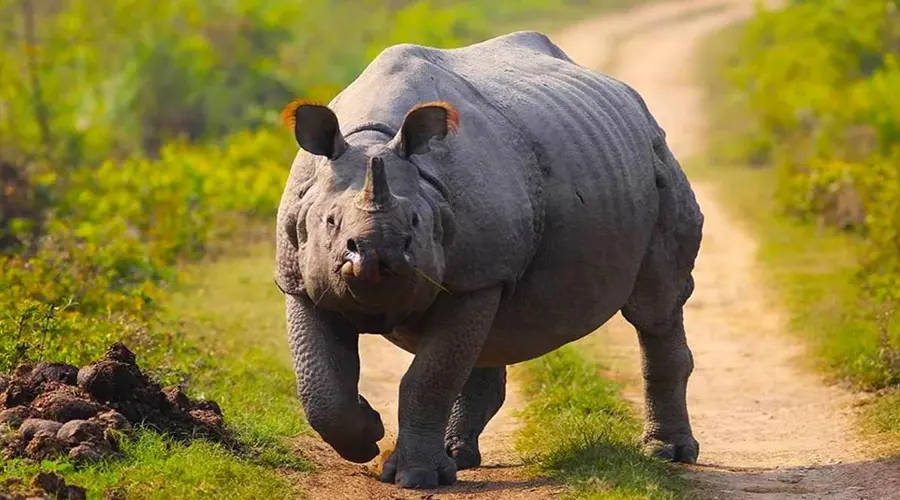
Famous for the preservation of rare one-horned rhinoceros, Kaziranga National Park is one of the richest national parks in the country. Boasting the highest density of tigers, Kaziranga is also acknowledged as the richest Tiger Reserve in the world. Breeding ground for elephants, wild water buffalo, and many avifaunal species, the park has received the prestigious status of a UNESCO Heritage site, especially for wildlife conservation. Right from dolphins to many migratory birds, the park offers visibility to many unique sights of animals and birds in their natural habitat.
Location: J94R+77C, Assam 785609
Manas Wildlife Sanctuary (Natural) (1985)

Manas Wildlife Sanctuary is a protected wildlife reserve and one of the UNESCO World Heritage sites in India. It’s located in the North-Eastern Indian state of Assam. The name originated from River Manas which is derived from the name of Goddess Manasa. The lush green forested hills and dense vegetation of the surrounding areas provide a comfortable environment for the several endangered species of animals. The Wild Life Sanctuary is a Project Tiger Reserve, Elephant Reserve, Biosphere Reserve, and a home for several endangered species like the Assam Roofed Turtle, Hispid Hare, Golden Langur, and Pygmy Hog. This park houses more endangered species than any other in India.
Location: M252+QF6, Manas Road, Barangabari Gyati Village, Dist Baksa, Gobardhana, Assam 781315
Heritage Sites in Sikkim
Khangchendzonga National Park (Mixed) (2016)

Holding natural and cultural significance Khangchendzonga National Park is India's first “mixed” World Heritage site, recognized by UNESCO. The national park boasts 17 alpine lakes and magnificent views of 9 mountain ranges, and spectacular wildlife with exotic animal species. This national park in Sikkim is home to the sacred Buddhist shrine, Tholung Monastery. The sprawling high-altitude national park also offers several trekking expeditions, starting from Yuksom and GreePandase with Leopards. While trekking, one can spot rare species of animals such as Red Pandas, Snow Leopards, Great Tibetan Sheep, Bharal, Musk deer, etc.
Location: M88F+VRV, Sakkyong, Sikkim
Heritage Sites in Chandigarh
Capitol Complex (Cultural) (2016)

The architectural work of Le Corbusier across many countries, including the Capital Complex of Chandigarh, was recognized as a World Heritage Site as part of an outstanding contribution to the Modern Movement. This was part of Le Corbusier’s work, which he did in 17 countries in the first half of the 20th century. It is spread over an area of around 100 acres and is a prime manifestation of Chandigarh's architecture.
The Capitol Complex in Chandigarh also hosts the legislative assembly for both the states of Haryana and Punjab, the High Court, and the Secretariat. Located in Sector 1, Chandigarh, this capitol complex was built when Chandigarh was being developed as the capital of Punjab in 1950 after the partition of India.
Location: QR42+MW5, Sector 1, Chandigarh, 160001
Heritage Site in Telangana
Kakatiya Rudreshwara Temple (Cultural) (2021)

The 800 years old Rudreswara temple, Ramappa Temple is a UNESCO World Heritage Site located in the state of Telangana in southern India. This Shiva temple is named after Ramappa who was the main architect who worked laboriously for 14 years when the temple was being constructed. Apart from architectural precision, the temple of Ramalingeshwara Swamy is famous for unique features like a roof built with bricks that float on water and the pillars producing musical notes when tapped in certain places. The temple was built during the reign of the Kakatiya empire in 1213.
Western Ghats (Natural) (2012)

A massive mountain chain spreading over an area of 7,953 sq km in the Western Ghats region of India was inscribed as a world heritage site in India in 2012. Recognized as the eight hottest hotspots of biological diversity in the world, this region's ecosystems highly influence the monsoon pattern in the country. Comprising a cluster of 39 strategic sites, the region brings together tiger reserves, national parks, wildlife sanctuaries, and reserved forests in the Indian states of Maharashtra, Karnataka, Kerala, and Tamil Nadu. The forests along the Western Ghats are home to about 325 species of flora and fauna, which included endangered, rare, and critically endangered species of plants and animals.
Location: A chain of mountains running parallel to India's western coast, approximately 30-50 km inland, the Ghats traverse the States of Kerala, Tamil Nadu, Karnataka, Goa, Maharashtra, and Gujarat.
Mountain Railways of India (Cultural) (1999, 2005, 2008)
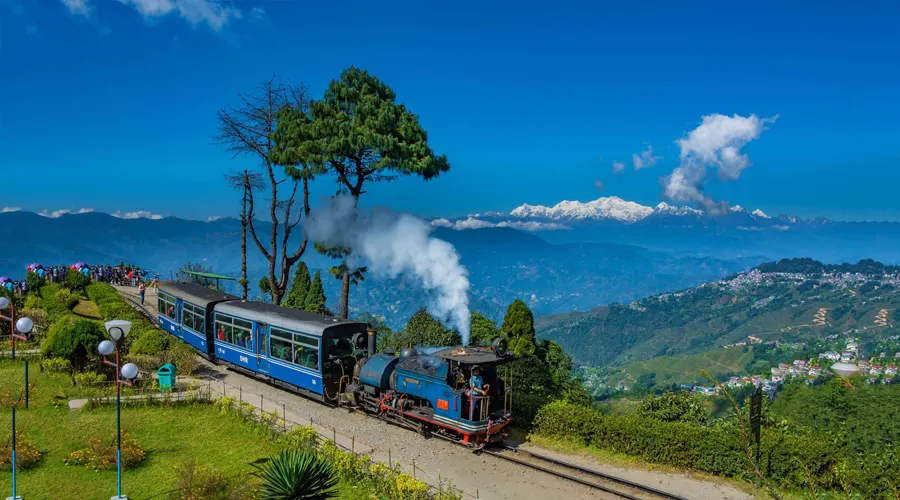
Three major operational mountain railheads, the Darjeeling Himalayan Railway of West Bengal, the Nilgiri Mountain Railways of Tamil Nadu, and the Kalka Shimla Railway of Himachal Pradesh were listed as the UNESCO World Heritage Site as these Mountain Railways serve as an inspiration for similar developments in different parts of the world. The Mountain Railways of India reflect an innovative transportation system and developments in technology that holds universal significance and are a model for other developing countries.
- The Darjeeling Himalayan Railway of West Bengal - A 610 mm gauge railway that runs between New Jalpaiguri and Darjeeling in the Indian state of West Bengal.
- The Nilgiri Mountain Railways of Tamil Nadu - The Nilgiri Mountain Railway (NMR) consists of 45.88km of a meter-gauge single-track railway that connects Mettupalayiyam to Udagamandalam in Tamil Nadu State.
- The Kalka Shimla Railway of Himachal Pradesh - The Kalka–Shimla Railway is a 2 ft 6 in narrow-gauge railway in North India which traverses a mostly mountainous route from Kalka to Shimla.


Comments (0)